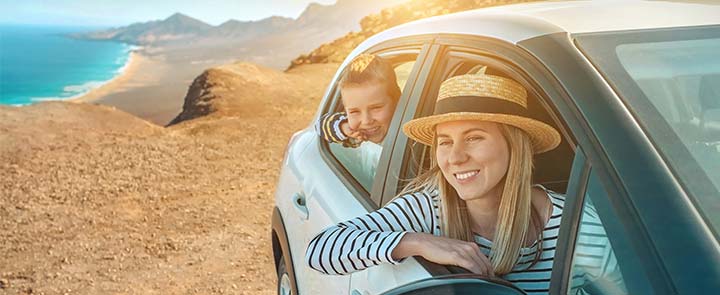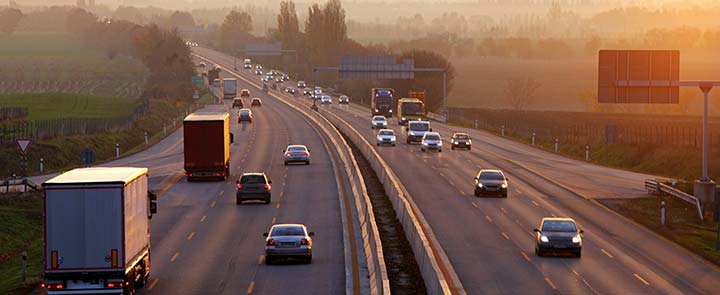
Spain attracts tourists from all over the world. We've put together a guide to driving in Spain.
Roads in Spain
Outside of the densely populated cities of Madrid and Barcelona, the roads of Spain have some of the lightest traffic in Europe - congestion is basically unheard of in more rural areas.
Unlike most European countries, where road improvements involve developing old stretches of road by repaving and repainting them, in Spain new roads are often built next to the old ones. This means that in many cases you will find three choices of road on which to drive: the original old road, the post-Franco new road, and the modern "autovia" divided highway.
Often it is best to stick to the most recently developed road - meaning you will likely choose the autovia - but in rare cases where you have to pay to drive on the autovia, you may decide to drive "off the beaten track" on an older road. If you take this option, you could find yourself as the only car on the road!
Access roads to main cities are prefixed by the city or province code - M for Madrid, SE for Seville, B for Barcelona - which are followed by one or two digits. Some minor roads do not have numbers - in 2004 most denominations of roads were changed to to a simpler format, but not all of them have been updated yet - so watch out for roads with one name, two names (old and new) or neither!
Motorways
Motorways are the fastest option when travelling by car. Motorways run all over Spain and are generally not very busy - this is because of high tolls that put off many drivers. Tickets are issued automatically when you enter the motorway, and when you leave the motorway you hand your ticket in at a booth.
Main roads
Main roads, which usually run adjacent to motorways, are often the most crowded roads to travel on in Spain. Drivers who wish to avoid high tolls on motorways will often choose to take the main roads, leading to dense traffic.
Secondary roads
Secondary roads are not recommended unless you are an experienced driver - they are the narrowest and those that run through the mountains often have unprotected roadsides. It's best to avoid these as not only do they take up to three times longer than other roads, they can also be dangerous during winter thanks to ice and snow.
Items to keep in your car when driving in Spain
When driving in Spain, every car is required to:
- Contain reflective waistcoats to be used in the event of a breakdown - in this event, you must put on the reflective waistcoat before leaving the car.
- Carry two red reflective triangles to use as a warning in case the vehicle breaks down.
- Carry spare bulbs, fuses and the tools to change them.
Spain driving rules
What side of the road does Spain drive on?
Spain drives on the right-hand side of the road. Your car hire will be set up for right-hand driving, with the steering wheel on the left side of the car.
Who has the right of way?
Drivers approaching an intersection must give way to all vehicles coming from the right.
Drivers already engaged in a roundabout have the right of way over drivers approaching the roundabout.
When entering a main road, drivers on secondary roads must give way to vehicles coming from either direction.
Vehicles on rails and emergency vehicles have the right of way over other drivers.
What is the speed limit in Spain?
Spanish road speed limits are 110km/h on motorways (autopista), 90km/h on main roads and 50km/h in urban areas.
What is the alcohol limit in Spain?
Do not drink and drive – the maximum amount consumed to be considered legal to drive is the equivalent of a glass of wine or beer.
Things to be aware of when driving in Spain
- Vehicle fuelling stations are frequent when driving around Spain and many of the main ones are open 24 hour and those that aren’t will list the nearest 24 hour service station
- It is against the law to drive whilst on a mobile phone and driving whilst on the phone may incur fines
- Seat belts are a legal requirement in Spain
- Be aware that some motorways are toll roads or autopista de peaje
- Undertaking on the right hand side is illegal in Spain
- You must not overtake another vehicle if there is a solid white line dividing the traffic lanes - you can only overtake if the white lines are split
Parking in Spanish towns and cities
- In towns and cities like Malaga there are parking zones marked in blue. However, there are ticket machines where you must pay parking fees and clearly display the parking ticket on the dashboard of your car.
- There are underground car parks around towns and cities that are usually cheaper than the blue parking zones.
- You must not park if the pavement border is painted yellow or red.
More information
For additional tips on driving in Spain, the following websites can provide additional information.
Do you need to make a claim?
If you’ve suffered damage to or loss of your hire vehicle due to theft, and you’ve purchased an insurance4carhire hire car excess insurance policy, we’re ready to help.
Related Guides

What insurance do you need to hire a car in Spain?
When you think of a holiday in Spain, you undoubtedly don’t think of the insurance you’ll need if you’re hiring a car. When you do, the rental car company will usually include basic cover as part of the deal.

Hot Weather Driving Tips
Long sunny days and heatwaves can provide the perfect opportunity to get out on the road, but there are a number of things to consider before heading out into the sun.

Top Tips for Driving a Hire Car Abroad
Having a hire car on holiday could save you the hassle of sorting out transfers. Not only that, it offers you the freedom to really explore and get to grips with your holiday destination...


